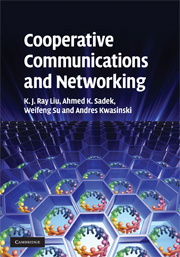2 - Space–time diversity and coding
from Part I - Background and MIMO systems
Published online by Cambridge University Press: 06 July 2010
Summary
The idea of using multiple transmit and receive antennas in wireless communication systems has attracted considerable attention with the aim of increasing data transmission rate and system capacity. A key issue is how to develop proper transmission techniques to exploit all of the diversities available in the space, time, and frequency domains. In the case of narrow-band wireless communications, the channel fading is frequency non-selective (flat) and diversities are available only in the space and time domains. The modulation and coding approach that is developed for this scenario is termed space–time (ST) coding, exploiting available spatial and temporal diversity.
In this chapter, we first describe the MIMO communication system architecture with frequency-non-selective fading channels, which are often termed as narrow-band wireless channels, and discuss design criteria in achieving the full space–time diversity. Then, we introduce several well-known ST coding techniques that can be guaranteed to achieve full space–time diversity.
System model and performance criteria
Assume that the MIMO systems have Mt transmit and Mr receive antennas. Channel state information (CSI) is assumed to be known at the receiver, but not at the transmitter. In narrowband transmission scenario, the fading channel is frequency-non-selective or flat, and is assumed to be quasi-static, i.e., the channel stays constant during one codeword transmission and it may change independently from one codeword transmission to another. In this case, diversity is available only in the space and time domains.
- Type
- Chapter
- Information
- Cooperative Communications and Networking , pp. 43 - 63Publisher: Cambridge University PressPrint publication year: 2008



